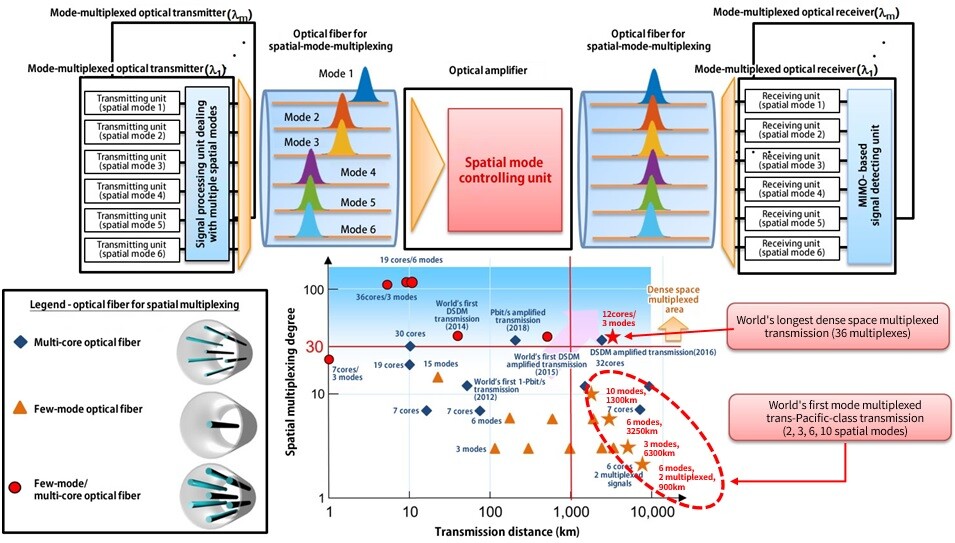05/15/2024
Construction of high-capacity next-generation optical backbone networksLong-haul optical transmission technology using spatial mode-multiplexed signalsNTT Network Innovation Laboratories
Overview
In response to the ever-increasing traffic demand, NTT is conducting research and development on fundamental technologies for optical transport backbone networks. Using a spatial mode-multiplexed optical fiber that can increase transmission capacity 10 times while maintaining the same diameter as conventional optical fibers, we succeeded in the world's longest distance (1,300 km) optical amplified relay transmission of 10-spatial-mode multiplexed signals. This technology is expected to contribute to the realization of future high-capacity long-distance optical transport backbone networks that exceed the physical capacity limit of existing optical fibers.
Background / Issues
Optical transport backbone networks have continued to respond to the enormous traffic demand. The transmission capacity has been expanded by more than six orders of magnitude in the 40 years since the introduction of commercial optical transport systems. While single mode fibers have been used as optical transmission media that support only a single spatial mode, in recent years, the physical transmission capacity limit (“capacity crunch”) of single-mode fiber has become apparent. To overcome this limit, we are conducting research and development on novel optical fibers and innovative optical transmission technologies using these fibers.
Advantage of this technology
- Maximizing the potential of transmission performance of optical fibers and realizing the high-capacity next-generation optical backbone networks.
Use Scene
- Next-generation networks
Explanatory chart

Technical explanation
In recent years, space-division-multiplexing technology has been intensively studied as a novel technological base for realizing next-generation high-capacity optical backbone networks by a number of research institutions around the world. This technology multiplexes signals by using, as transmission media, optical fibers with a new structure that uses multiple cores and spatial modes as optical paths of light. We believe that this technology will dramatically expand the transmission capacity per optical fiber and overcome the capacity crunch.
To establish core technologies for space-division multiplexing, since 2008, NTT has been engaged in research on optical transmission fibers, optical amplifiers, connection devices, optical nodes, and optical transmission technologies in cooperation with related institutions. In 2018, by integrating our research results and applying a system design suited to the optical characteristics of each spatial mode, we have succeeded in the world's first demonstration of mode-multiplexed trans-Atlantic-class transmission (6,300 km). In 2020, we further extended the transmission distance and successfully demonstrated the world's longest mode-multiplexed trans-Pacific transmission (9,000 km). In the same year, we demonstrated the world's longest high-density spatial multiplexed transmission over 3000 km using a few-mode multi-core optical fiber with 36 optical paths by combining core and spatial mode-multiplexing technologies. In 2023, we succeeded in the world's first amplified relay transmission experiment of 10-spatial-mode multiplexed optical transmission over the world’s longest distance of 1300 km. We have, thus, demonstrated for the first time the potential for long-haul transmission of 10 times the information capacity while maintaining the same diameter as conventional optical fibers using spatial mode multiplexed fiber.
Department in charge
NTT Network Innovation Laboratories - Transport Innovation Laboratory